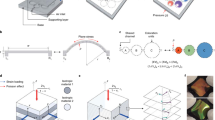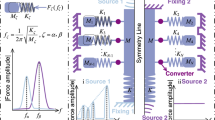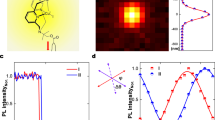Abstract
Liquid-crystal elastomers (LCEs) are rubbers whose constituent molecules are orientationally ordered. Their salient feature is strong coupling between the orientational order and mechanical strain1. For example, changing the orientational order gives rise to internal stresses, which lead to strains and change the shape of a sample. Orientational order can be affected by changes in externally applied stimuli such as light. We demonstrate here that by dissolving—rather than covalently bonding—azo dyes into an LCE sample, its mechanical deformation in response to non-uniform illumination by visible light becomes very large (more than 60° bending) and is more than two orders of magnitude faster than previously reported2,3,4. Rapid light-induced deformations allow LCEs to interact with their environment in new and unexpected ways. When light from above is shone on a dye-doped LCE sample floating on water, the LCE 'swims' away from the light, with an action resembling that of flatfish such as skates or rays. We analyse the propulsion mechanism in terms of momentum transfer.
This is a preview of subscription content, access via your institution
Access options
Subscribe to this journal
Receive 12 print issues and online access
$259.00 per year
only $21.58 per issue
Buy this article
- Purchase on Springer Link
- Instant access to full article PDF
Prices may be subject to local taxes which are calculated during checkout




Similar content being viewed by others
References
de Gennes, P.G. Réflexions sur un type de polymères nématiques. C. R. Acad. Sci. Ser. B 281, 101–103 (1975).
Finkelmann, H., Nishikawa, E., Pereira, G.G. & Warner, M.A. New opto-mechanical effect in solids. Phys. Rev. Lett. 87, 015501 (2001).
Cviklinski, J., Tajbakhsh, A.R. & Terentjev, E.M. UV isomerisation in nematic elastomers as a route to photo-mechanical transducer. Eur. Phys. J. E 9, 427–434 (2002).
Yu, Y., Nakano, M. & Ikeda, T. Directed bending of a polymer film by light. Nature 425, 145 (2003).
de Gennes, P.G. Possibilities allowed by polymer reticulation in the presence of a liquid crystal. Phys. Lett. A 28, 725 (1969).
Warner, M. & Terentjev, E.M. Liquid Crystal Elastomers (Clarendon, Oxford, 2003).
Finkelmann, H., Kock, H. & Rehage, G. Investigations on LC polysiloxanes: 3. Liquid crystalline elastomers—a new type of liquid crystalline material. Makromol. Chem. Rapid Commun. 2, 317 (1981).
Shenoy, D.K., Thomsen, D.L., Srinivasan, A., Keller, P. & Ratna, B.R. Carbon coated liquid cystal elastomer film for artificial muscle applications. Sensors Actuators A 96, 184–188 (2002).
Courty, S., Mine, J., Tajbakhsh, A.R. & Terentjev, E.M. Nematic elastomers with aligned carbon nanotubes: New electromechanical actuators. Europhys. Lett. 64, 654–660 (2003).
Finkelmann, H., Kim, S.T., Munoz, A., Palffy-Muhoray, P. & Taheri, B. Tunable mirrorless lasing in cholesteric liquid crystalline elastomers. Adv. Mater. 13, 1069–1072 (2001).
Clarke, S.M., Tajbakhsh, A.R., Terentjev, E.M. & Warner, M. Anomalous viscoelastic response of nematic elastomers. Phys. Rev. Lett. 86, 4044–4047 (2001).
Terentjev, E.M., Hotta, S., Clarke, M. & Warner, M. Liquid crystalline elastomers: dynamics and relaxation of microstructure. Phil. Trans. R. Soc. Lond. A 361, 1–12 (2003).
Janossy, I., Lloyd, A.D. & Wherrett, B.S. Anomalous optical Freedericksz transition in an absorbing liquid crystal. Mol. Cryst. Liq. Cryst. 179, 1–12 (1990).
Palffy-Muhoray, P., Kosa, T. & E, W. Brownian motors in the photoalignment of liquid crystals. Appl. Phys. A 75, 293–300 (2002).
Kupfer, J. & Finkelmann, H. Liquid crystal elastomers: influence of the orientational distribution of the crosslinks on the phase behaviour and reorientation process. Macromol. Chem. Phys. 195, 1353–1367 (1994).
Rosenberger, L.J. Pectoral fin locomotion in batoid fishes: undulation versus oscillation. J. Exp. Biol. 204, 379–394 (2001).
Hu, D., Chan, B. & Bush, J. The hydrodynamics of water-strider locomotion. Nature 424, 663–666 (2003).
Temmen, H., Pleiner, H., Liu, M. & Brand, H.R. Convective nonlinearity in non-Newtonian Fluids. Phys. Rev. Lett. 84, 3228–3231 (2000).
Acknowledgements
This work was supported by the US National Science Foundation and the Department of Energy. We thank T. Toth-Katona for his help with Fig. 4a.
Author information
Authors and Affiliations
Corresponding author
Ethics declarations
Competing interests
The authors declare no competing financial interests.
Rights and permissions
About this article
Cite this article
Camacho-Lopez, M., Finkelmann, H., Palffy-Muhoray, P. et al. Fast liquid-crystal elastomer swims into the dark. Nature Mater 3, 307–310 (2004). https://doi.org/10.1038/nmat1118
Received:
Accepted:
Published:
Issue Date:
DOI: https://doi.org/10.1038/nmat1118
This article is cited by
-
Functionally antagonistic polyelectrolyte for electro-ionic soft actuator
Nature Communications (2024)
-
Self-regulated underwater phototaxis of a photoresponsive hydrogel-based phototactic vehicle
Nature Nanotechnology (2024)
-
Light-driven peristaltic pumping by an actuating splay-bend strip
Nature Communications (2023)
-
Synthesis of biobased functional materials using photoactive cinnamate derivatives
Polymer Journal (2023)
-
Polarization-driven reversible actuation in a photo-responsive polymer composite
Nature Communications (2023)



